#it all makes kind of some sense if we're talking about elves here
Text
Ok, so Noldolantë, "The Fall of the Noldor" is a lament composed by Maglor about what happened before, during and after First Kinslaying at Alqualondë. It's such a good song that it's played regularly in Aman and Valar listen to it often (I swear, I swear it was in the Silmarillion I just can't find it now).
It's also a more or less common fanon that Maglor continues writing Noldolante through the whole First Age. Makes sense - it's about fall of the Noldor, and Noldor did a lot of falling back then.
Headcannon time: So my first thought was that Noldolante must a long, long, long epic of a song. So it probably has many parts, right? Iliad has 24 books/parts, somehow I think Noldolante would be at least just as long, and there are longer epics. And again, just like Iliad, unless you're a scholar, in the daily life you don't really listen to/read the whole thing, just reread and repeat the most dramatic fragments. What I'm trying to impress upon you all is that the story would have different segments, or chapters, if you will.
And if Maglor continues to write the story during the FA, there would absolutely be a moment in the lament where the OG Noldolante becomes Noldolante 2, and even Noldolante 3. There may be the same musical motif or something, I decided that Maglor IS that good of a bard to keep it all consistent enough so you know it's all the same story, but the style changes a lot - it's been 400 years in the making, let The Music Elf have fun!
So, Point 1: Many, Many Parts, basically Maglor's FA WIP
My second thought was that, while Feanor invented his alphabet, elves learned their history mostly through oral tradition aka songs and spoken stories. Noldolante is definitely a historical record, where a historical event was archived for future generations.
(It was a also a way to deal with grief, guilt and blame Maglor and all Noldor have faced regarding First Kinslaying - free therapy! But that's not what this post is about)
Archived.
My 2.5 thought was that Noldolante isn't just recallings of how pretty and horrified the beach looked during the murdering or how mad and sorrowful the sea was at everyone during the voyage or even how awesome and charismatic Feanor looked during his speeches that every single Noldo was ready to fight Morgoth barehanded in his name - no, this is a record of who killed who, who got killed by whom, and how.
Noldor and Teleri knew each other (were friends, even!) before the First Kinslaying, so I'm confident that after a lot of interviews, detective work, and cross-referencing, Maglor could and would create a very good... name list. Practically every Noldo and Teler present during First Kinslaying would get a stanza in a song, more if he killed someone, most if he killed many people. Killers and killed would show up twice, first in a fragment listing the killers and their victims, then in a part listing the victims and their murderers. Basically it's the same thing twice, but from different POVs. With when, where and how included.
(It was seen to be in bad taste to compare kills during Maglor's Regency, when most of his interview-part work happened. People did it anyway. There were a Saddest Kill, Funniest Kill, and Weirdest Kill discusions. There was a Tier List. These were weird times to be a Feanorian Noldo.)
(It WAS in Bad Taste, but at least people talked about it. I cannot stress enough how much free therapy this lament provided)
(Little did they know, when Teleri started getting reembodied in Aman, they had very similar discussions, but more in a "I can't believe he killed me like THAT" way. Long, long, long after the First Age. Noldolante is a gift that keeps giving)
So, Maglor had all the historical grith and no common shame to create a "We Killed All These People And We Feel Bad About It" banger of a song, and every Noldo had a very personal reason to at least remember the fragments they are in. It's a hit on a scale never seen before.
(I'm not sure how to tackle the issue of Nolofinweans and Arafinweans learning about Noldolante after crossing the Ice. But there were discussions. There was anger, there was "????", there was controversy. Basically, the song got bigger and bigger rep no matter what your opinion on it was. By the time of Mereth Aderthad it was an important cultural and political piece and at least Fingon's forces were included in the main song. It had parodies.)
Point 2: Archive Function/Kill count storage. Cultural phenomen, every Noldo included
This is where my personal nonsense begins: Main Noldolante was done, there was nothing more to say about First Kinslaying, all killings and deaths were well documented.
But the Siege started. And the Noldor kept dying.
It was less dramatic than it sounded - between the big battles the siege was maintained, but orc raids also happened and sometimes one to few Noldor died in skirmishes. The legal procedure was to document the death of a fellow elf and send a word to king Fingolfin. The cultural procedure, technically started by Feranorians but adapted by many more, was to send the name, common characteristics and cause of death to Maglor's Gap. After few months, King Fingolfin would send reinforcements, short condolences and financial compensation if they had family. After few months, family of an elf would also receive a personal lament for them and a place for them in a Noldolante.
Yes, every lament Maglor created in that time was technically part of the Noldolante. Noldolante 1.5, if you will. Laments make in that time were very customized, and simpler than Noldolante Main, but were still considered a part of the same song. Of course, nobody was expected to know and remember laments for every single Noldo, younger Noldor born in Beleriand could even only know fragments about their family members. Only Maglor would ever know Noldolante in full, but it was understood that everyone had their place in The Song.
The results of Great Battles were harder to document, but Maglor did that. Of course, Dagor Bragollach was hard on him personally, but he worked his way through.
(High King Fingon forbade creating laments for his father. There were no songs for Fingolfin. Apart from in Noldolante, of course. Of course. Maglor did not share the lament with anyone, but he sat long hours and many nights with a blank paper before him, looking at the candle flame and thinking of the past and the future. The song unsung, but there)
Nirnaeth was... Maglor was never more hated and more approached at the same time than then. Still, Noldolante grew and grew, as if people knew the end was near.
It was Second Kinslaying that destroyed the myth of Maglor's song. Feanorians didn't know the Sindar they killed, but surely, they couldn't just left their names unmentioned like they did with orcs? So, Noldor talked, but the battle happened in caves - it wasn't uncommon to find dead bodies in empty rooms, with no witnesses to what happened. Surviving Sindar didn't want to share any names, even when Maglor strong-armed some into talking with him, and good for them. Maglor made a big lament anyway. Maglor, wild, with no shame and dead brothers, with legacy crumbling around him. Noldolante, with holes.
After Third Kinslaying, Noldor didn't want to talk. Lament for Sirion didn't have any names. Clearly, songs weren't a way to go anymore, it was always about live witnesses. And so Maglor raised the twins.
Lament for Maedhros was sung repeatedly. There was no one to hear it.
Point 3: Only Maglor knows Noldolante in full. But that doesn't matter, because everyone knows the important part: the Noldolante is finished. The Star of Hope rises in the West and the story goes on. The Fall has ended.
#silm#silmarillion#noldolante#maglor#yet another post that went in different direction than I planned#started with meta went into headcannon and ended with fanfic angst#I wanted to end it with crack!!!#I mean. I mean#it all makes kind of some sense if we're talking about elves here#but guys Noldor had Men and Dwarves as allies#Maglor would want them in his Historical Record song#I think with Dwarves they would mainly refuse when he asked them if they wanted a part in Noldolante#so maybe he would only get some allies and personal friends of Maedhros in#but Men#guys Men. they would agree and they would make lists and it would become Clown City so fast#but Sons of Feanor aren't known for their ability of knowing when to quit#so Maglor has a Noldolante 3.0 Standard Version with 254 Parts that has Elves and an Occasional Dwarf Only#and Special Version Noldolante Deluxe Extra Edition with 547398134 Parts that includes Men#everyone is included you don't have to die in battle#all common causes of death have a dedicated jingle to them#to the point you know a man's cause of death after 3 notes#these parts of Noldolante well the music bit actually survived into the Fourth Age#the words are gone but the music is played at funerals in some places#The Noldolante Main survived only in parodies though#actually Finished Noldolante is a very good thing huh#as in no more Fall of The Noldor#they can finally catch some break#I believe that during Maglor's Regency Era all Noldor did was Processing. and breeding horses.#Noldolante? more like Maglor Finally Discovers Shame: A Story#I think some personal revelations on legacy and connections between children and life's works would be made
240 notes
·
View notes
Text
Your Aunt's Spirit In You :: Callum & Amaya, a Meta
Was thinking about these two due to writing a scene between them in a recent oneshot, and then about the similarities they have, so thought - why not? Especially for a shorter meta than more of the long form ones I have siting in my drafts, let's talk about Callum and Amaya
As always, SIMILARITIES first:
Both loyal siblings to a monarch (Sarai through marriage, Ezran through birth)
Taken captive and interrogated by elves
Willing to sacrifice themselves for the good of the group (special shout out to 3x01 which puts this back to back * )

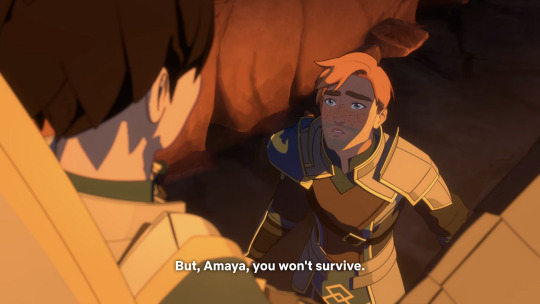
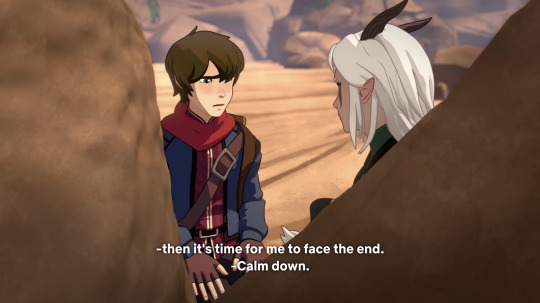

* This is slightly negated by Rayla, not Callum, being the one to actually risk her life (as she talks Callum out of risking his own quite easily) whereas Amaya goes through with it. Still, Callum's sentiment and willingness is there (and on multiple occasions), so it's included. ("I need you to kill me" being another example)
Skeptical, distrustful, and good at reading people (even if Callum changes his mind about Rayla and Amaya does not about Viren)
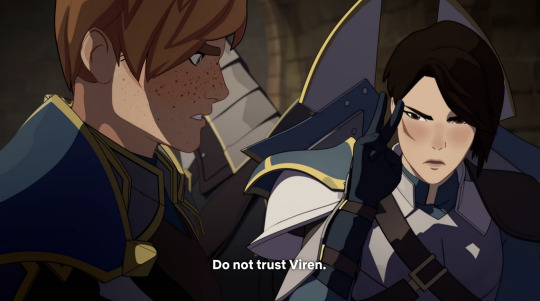
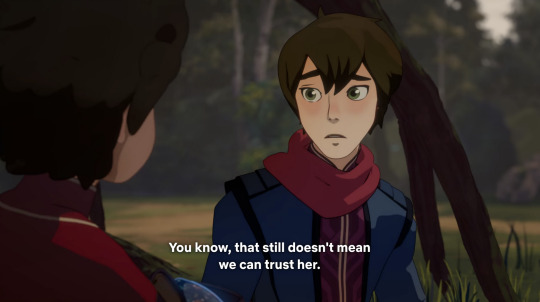
Good planners / generals (see my General Callum tag here)
Often times more decisive than their partner (Rayla often hesitates, which Janai worries about as well) and encouraging them to prioritize their own needs as well above just their 'duty'
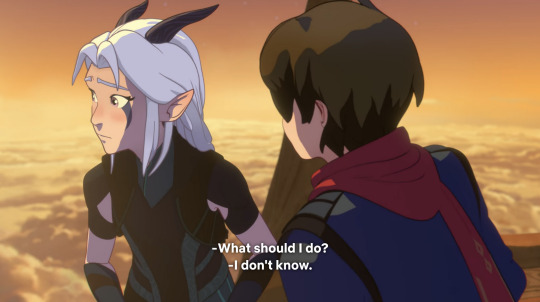
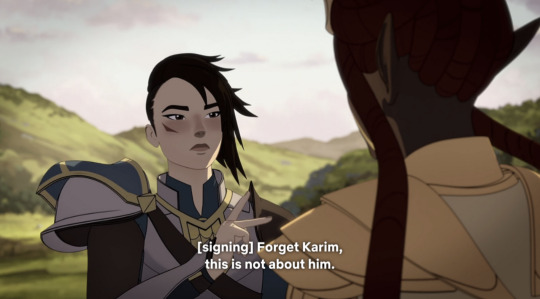
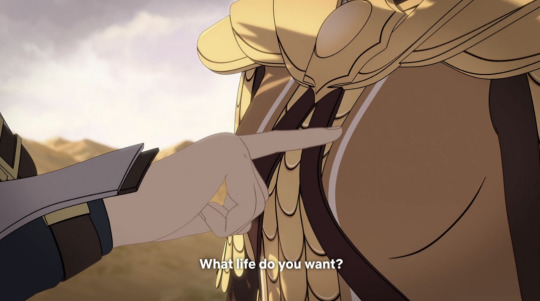
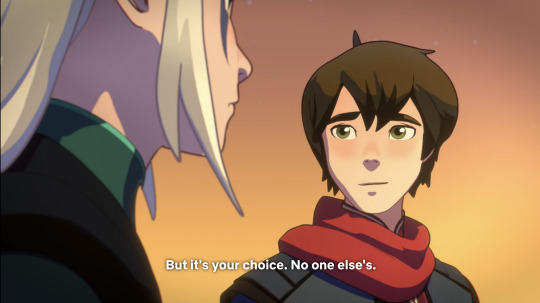
In 4x01, they are both worried about secrets (as a result of war based trauma) and potential attacks, even though both 'secrets' wind up being something positive and wonderful (successfully for Amaya - as she is proposed to and happily rejoices with her partner - and an attempt for Callum, as it leaves him forlorn because his partner is still missing)

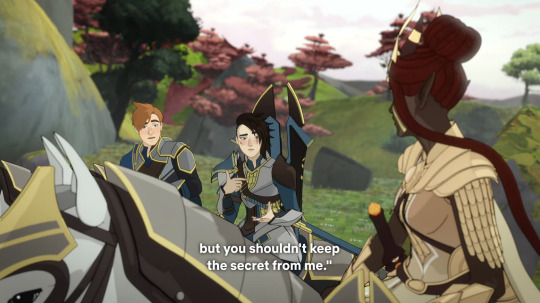
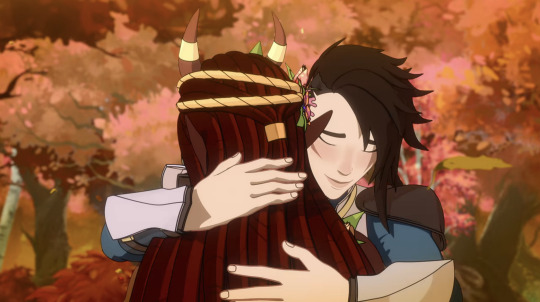

Slightly darker sense of humour, maybe ("Now that you'll officially be my little brother, I'll try not to beat you up too much" + "Besides, she only eats three people a day. It's a small price to pay for peace")
And last but not least, there is Janai's assessment of their similarities (aka the meta title) that accompanies the soundtrack piece of "Like Aunt, Like Nephew".
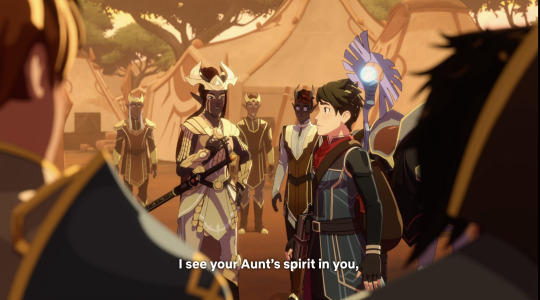

Callum does often undertake dangerous quests / make dangerous choices (travelling across the world to return a dragon egg, throwing himself off a mountain, running into what he believes to be a trap, etc). This is, however, much like how Aaravos' assessment of Callum in 4x04 ("and my favourite, the human mage, already tainted by darkness, and destined to play right into my hands") is true for all of his mage pawns up to that point (Ziard, Claudia, and Viren in the past), true of just about every character in the show. Which makes sense - in an action/adventure fantasy show, most of the characters are going to have to be okay about throwing themselves into danger just by proxy of genre. In most of the trio scenes where someone is hurling themselves into danger, it is usually Rayla first - and then Callum, stepping up if/when she can't do something on her own.
As you might've noticed while there are similarities, outside of their skepticism and willingness to sacrifice (which is again, something most characters in the show have) there aren't that many that go beyond more surface level "these events both happen to these characters," as Amaya and Callum's mindsets aren't that similar, which are the bulk of the main differences we're going to talk about next.
DIFFERENCES:
Prejudice (or therefore lack of)
Amaya is very prejudiced against elves ("Moonshadow elves - the worst kind [...] Don't worry, Callum, I've slain monsters before") at the beginning of the show, whereas Callum never is. He still holds some poor misconceptions (mostly the blood drinking) but he still always sees them as 1) people and 2) therefore worth reasoning with: "Can't you just make peace with them? You don't want to die, I'm sure the elves and dragons don't want to die, so everyone agrees"and his first conversation(s) with Rayla.
2. The ways in which Amaya is similar to Viren are largely different than the ways Callum is similar to Viren.
Amaya devoted her life to safeguarding the Breach and their kingdom's borders, a form of security that Viren was worried about and continued to be worried about once he came into power. Amaya and Viren can both be a little two-faced, willing to present a trusting front and hide their ulterior motives (most notably from each other, and something Rayla has in common arguably with both of them), whereas Callum is incredibly honest most of the time and is very bad at covering up his emotions (something he also has in common with Rayla, since although she often tries to cover things up, she routinely fails at it).
Viren is willing to send his children after the princes in spite of the danger of their secret missions ("if you must choose, choose the egg") and Amaya is willing to hold the Breach rather than go after her nephews, leaving Corvus to do so in her stead. This is very different than Callum, who automatically and often times insists on going along with his loved ones (Ezran, Rayla) when they're embarking on dangerous journeys of their own.
On that note, Amaya and Viren are both also taken captive by the Sunfire elves and given the Trial of Light, with very different outcomes that S5 also reaffirms for Callum, so let's talk about it:
3. The Light Will Decide Your Fate
During Janai's interrogation of Amaya, and Finnegrin's interrogation of Callum, the two respond very differently. Both Janai and Finnegrin want information, but Janai doesn't resort to torture even when Amaya remains entirely silent on any and all matters, and Finnegrin keeps pushing at Callum (and Callum keeps giving up information) even if he doesn't give up what Finnegrin wants, at first.
Amaya's trial is specifically about whether or not she's "pure of heart" or, more accurately, whether or not she's done dark magic. Her interrogation and test, if you will, ends with her passing it - to Khessa's surprise. Amaya is not a mage, and certainly not a dark mage, and is therefore going to interact and approach the world differently than a mage - human or elven or otherwise - would. Callum's interrogation and test is also about dark magic, and he does not 'pass it', lmao.
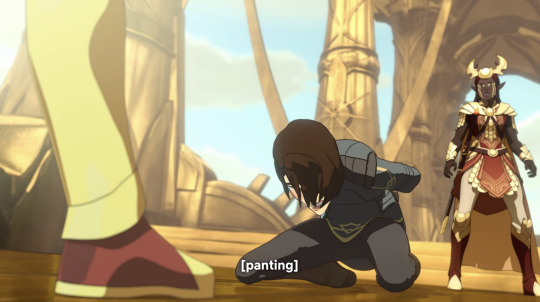
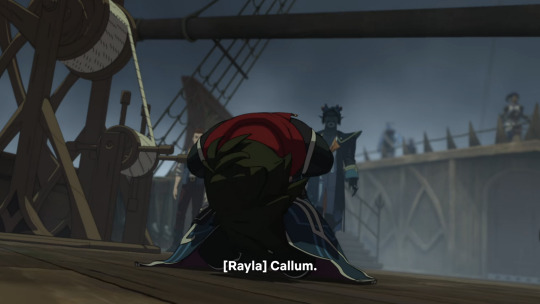
Because where Amaya had to confront the Light, Callum had to confront his Dark.
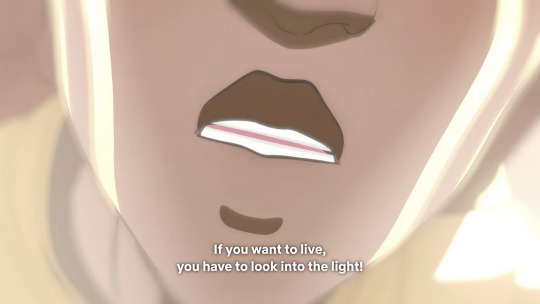
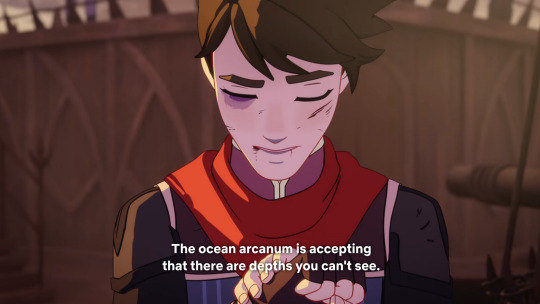
This is where we get into more of the mindset differences.
Amaya is willing to cut her losses (if she cannot successfully defend the Breach, she will destroy it, circa 3x01) but Callum almost never does (staying too late in the Great Bookery, for example; holding onto hope that Harrow might be alive even when he knows deep down he knows better, etc). Amaya refuses to give up the Sun Seed for her partner's life, knowing it safeguards a bright future and is what Janai would want her to do; Callum does give Finnegrin the spell and does dark magic to save Rayla, even when she wouldn't ultimately want him to do either of those things on her behalf. 5x08 makes this comparison particularly clear by juxtaposing these two deals and scenes throughout the episode.
Part of this is because, as Amaya acknowledges, for a great deal of her life, she and Callum had very different ideas regarding strength - which is exactly what allows these perspectives to switch:

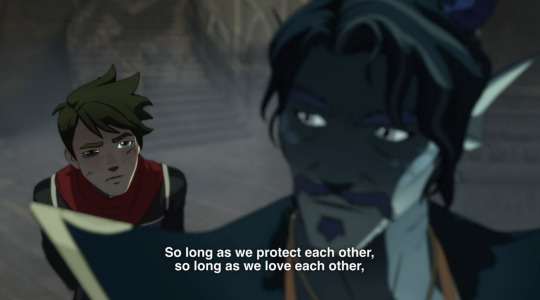
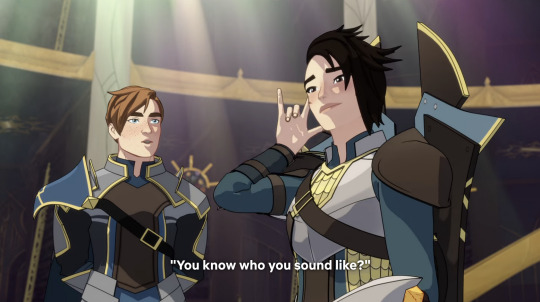


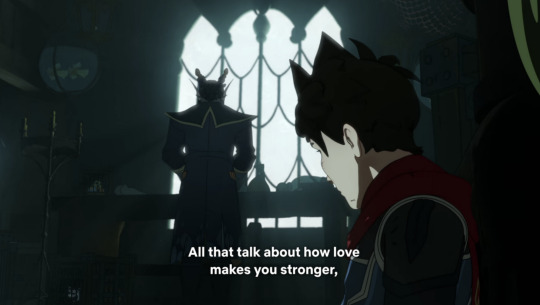
When she died, I felt lost and weak without her. I hated feeling that way, so I learned to be strong alone. Stoic, strong... and lonely.
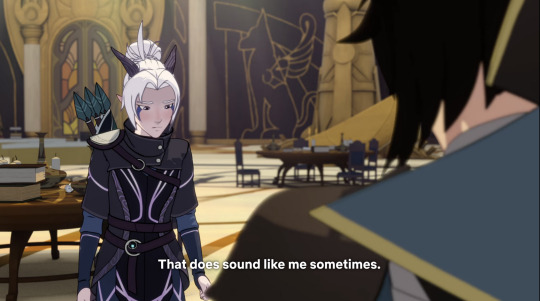
But the last two years have changed everything. Meeting Janai, falling in love, I am stronger than I ever was... because we are stronger together. And I realized that was the real truth of me and Sarai, too.
Callum has, up until about halfway through 5x08, always believed that he (and others) are ultimately stronger together, and we see this reflected through the first four seasons and into season five. However, the back half of 5x08 begins to greatly challenge this. Meanwhile, this is something that both Amaya and to a more detailed degree, Rayla, have had to learn. Because, when it comes to how they've responded to trauma, Amaya and Rayla are more similar to one another (and arguably to Viren in this way) than Amaya is to Callum, who by and large has a very different trauma response.
CONCLUSION (??)
While Amaya and Callum do have some similarities, Amaya is not extraordinarily similar to either of her nephews - Callum included - due to their differences in occupation, mindset, and trauma response. The similarities they do share are mostly things that they each share with Viren (such as skepticism) or share with most of the general cast (intelligence - although Callum is a standout - and bravery, for example). Most of their parallels, therefore, are put there to provide contrasts within similar themes (mostly in S1, 4x01, and 5x08), and they do not parallel more than any particular pair of characters in the show (seriously, you could throw a dart and probably find parallels between almost anyone, the show is so steeped in them, so looking at consistency and structure is key). Thank you for reading and I hope you enjoyed.
—Dragons out
#tdp amaya#tdp callum#tdp meta#the dragon prince#tdp#analysis series#amaya#punching someone in the face is not a thematic parallel in this show i'm sorry to report#however these two do have their similarities & differences#analysis#arc 1#arc 2#multi
116 notes
·
View notes
Note
Hey, remember Loki tried to do a genocide? Oh, wait that was because internalized racism. You can't blame Loki for that. Let's make sure to never address that. Also let's have the second Thor portray a genocide as necessary for peace.
Hey anon, remember when Thor attempted genocide of Jotuns first, because his party was cancelled and he was called a princess? And then it was never addressed, and he wasn't even banished for that crime, but because he insulted and disobeyed Odin?
Speaking of Odin, remember he had condemned Jotuns to a slow death, aka a slow genocide because he had taken their Casket which they needed so their planet won't be destroyed? And while we're at it let's remember how he drowned entire realms in tears and blood while conquering them? And he was still portrayed a hero and as a good person and Thor's guide in TR?
Remember Gamora and Nebula helped Thanos do acts of genocide?
Remember Mobius actively participated in genocide of numerous timelines?
I can go on. The list can continue for almost every hero coded character in MCU. Many of these characters were redeemed? So was Loki! You might wanna work on your double standards. I suggest you start with my "Spot the Hypocrisy" series.
Your reading comprehension needs work too. Because it seems you can't differentiate between when sth is explained vs. when sth is excused. When people say Loki attempted genocide because of his internalized racism, they are trying to explain his reasons and his state of mind, not excusing them. No one in fandom EVER said Loki is free of blame. He is very much responsible for his horrible actions.
Now let's talk about TDW. The movie has generally a neutral narrative. It tells you the story from a third person pov and sometimes from some of character's pov. The story at the start of the movie is from Odin's pov to imitate the way the first Thor movie started. With a story from Odin's pov.
Unlike Thor 1, the subtext of Asgard's bloody past that defeats the enemies to the point of genocide and complete destruction is more clear in TDW. There is this line" Malekith sacrificed his own people in desperate attempt to lay waste to Asgard's army" which is such bs, specially if you know how propaganda works. I mean Malekith escaped sure, but did the NoBLe AsGaRdiAn ArMy have to kill unarmed civilians too?
Then there is the scene when Jane asks Odin what happened with the Dark Elves that had peace for thousands of years, and Odin said:"He killed them all". There is a sense of unease in the scene, the way camera focuses on Jane's face who doesn't speak and presses her lips together clearly upset at this. The narrative doesn't condone it.
TDW is actually the only movie that goes out of its way to show how Odin is a very flawed and hypocrite character and that his actions are wrong. In Loki's trial he isn't shown to be in the right. He is portrayed as cruel and spiteful. He tries to force Thor in a path Thor clearly doesn't want. He looks down on humans and insults Jane comparing her to a goat. His beliefs aren't meant to be taken as correct ones and that includes his views on Bor and Dark Elves' genocide. Then he ignores Thor's counsel, wanting to "sacrifice as many Asgardians as needed" for his revenge. You're supposed to draw a parallel here between Malekith and Odin, both after the revenge no matter what the cost. You're not supposed to be on his side and accept his pov.
That's what the narrative aims to do and it's actually a good narrative because it needs for you to think and try to connect the dots yourself. It respect the audience's intelligence. But people these days wanting everything to be spoon fed to them. They want the narrative to plainly say "this is bad, this is good" in a tell not show kind of way which is such a lazy type of writing and boring to engage with. And as result people don't learn the skill necessary for interpreting art. So as my last suggestion, work on that skill too.
56 notes
·
View notes
Note
Since the topic of Ismelda came up and no one ever talks about her 🙈😅 I feel like JC doesn't know what to do with her (?). Like they didn't know what to do with Tulip so she appeared less and less, only like a cameo, there was the Cook Off but that tlsq came and went, and she was the least memorable character in there.
But Ismelda is weird cause they seem like they want to include her but don't know how? They can't decide whether she's getting nicer or is still the same old Ismelda. If she's over Barnaby or not. If she's Merula's friend or not.
One of the SQ that most gives me this feeling is The Quibbler - that no one talks about it ever, but I loved that tlsq - in which we see her doing something half understandable (a werewolf in school is dangerous and Dumbledore is an idiot), half unacceptable (especially because it's Chiara we're talking about).
But the thing is, we see her hanging out with a different pair of kids every scene like little henchmen, which is already unlike her, but also several of them were Gryffindors, and it's so OoC.

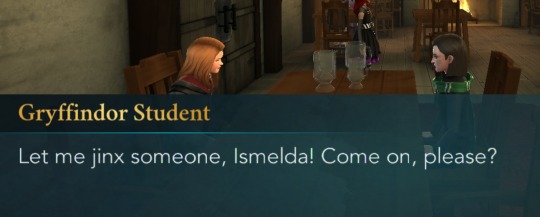
And I also didn't entirely understand her purpose here. Was it for the money? The pleasure of screwing over Dumbledore? Screwing over the werewolf? It was a really bad thing she almost did and I don't get how JC wants us to view her, because then we get her really friendly in other tlsqs of the same year, which returns with my theory of they're confused about what to do with her.
(Sorry this is stupidly long).
No worries about it being long! In return, you’re getting a pretty long answer. Apologies in advance because I’m gonna be very critical about “The Quibbler” TLSQ as it’s one of my least favourite quests, and I believe that Ismelda is not even its biggest problem.
But first things first. It’s probably just my nit-picking, but I still want to talk about it. I wouldn’t really compare the situations between Tulip and Ismelda. I believe that the main reason why Tulip was moved to the side is her strong connection to the main story. It was revealed by Matt London that her wand is a hand-me-down from her grandmother who attended Mahoutokoro, her parents work at the Ministry (where R might have bigger or smaller influence), there was the whole thing with her friendship with Merula, and Matt London just seemed to be fond of her in general. The problem is that Jam City got lost with their main story at some point. I believe that some of the elements I mentioned about Tulip might still be important, but I think that the problem is not necessarily that Jam City doesn’t know what to do with Tulip – they don’t know what to do with the main story. And Tulip suffers because of that.
I mean, look at Tulip in Y4. She had her whole investigation on Rakepick and the Cursed Vault which led her from House-Elves to Hogsmeade. Then, it was just dropped like a hot potato. Sure, there might be an in-game explanation for that: she was silenced by Rakepick. I mean, there’s no way Patricia didn’t learn about her investigation, and if she was discovering things faster than MC was supposed to, then Rakepick might’ve done something with it. It’s more likely, though, that JC started getting confused with the main story. Too bad that all notes they have on Tulip when it comes to future plans are about that. Anyway, the end result is kind of the same: that they don’t know what to do with Tulip. But as I said, I’m nit-picking.
Now, the situation with Ismelda is very different, in my opinion, because I don’t think she has much direct connection to the main story at all. What I mean by that is that she’s not really interested in the Cursed Vaults, for example. I believe that she joined Merula mainly because she wanted to belong. I don’t know, she just never really showed that she might care about the treasure or even the search itself. Because of that, the writers could work on her just as a character: someone who’s not exactly MC’s friend, but also is not as antagonistic as Merula. And that’s good! But ultimately, I suppose that Ismelda became a victim of the major change in the writing team by the end of Y5.
I talked about it a bit in my analysis on how MC was supposed to use Crucio on Rakepick, perhaps you recall. Either way, I strongly believe that there was some big change around that time. It even can be seen in our recent discussion about Rowan and Barnaby: how the writers seemingly don’t remember that Rowan tutored Barnaby for years etc. And I suppose it’s just the same with Ismelda. Notice how at the beginning of Y6, MC doesn’t remember at all that Ismelda is not that bad. We also totally abandoned the conflict between Ismelda and Merula. It’s not exactly that they grew apart because in Y6Ch13, there’s a scene where we learn that Ismelda still spies for Merula, for example. On the other hand, Merula hangs out with Ben suspiciously often – and Ismelda seemingly doesn’t have any reaction to that. Their relationship is still weird like that in Y7, actually. But what happened with Ismelda’s jealousy from Y5?
Now, the thing with her crush on Barnaby actually seems pretty realistic to me personally. I mean, as someone who used to have a big crush on their friend, I have to say – it’s not that easy to simply say: “Oh, I’m over with that!”, but also you want to be over with that, so it just ends up being very confusing. Of course, it could be as well the case of inconsistent writing, too, but that one thing doesn’t bother me much.
Moving to “The Quibbler” TLSQ, though… I don’t want to sound dismissive or anything, but I honestly don’t think there’s any point in trying to understand Ismelda’s motivation there or what the writers wanted us to think – and that’s simply because I doubt that its creator put much thought into it at all, to begin with. And the most problematic part of it is actually Chiara.
First of all, Chiara was super OoC in this quest. We know from the main story that she likes Divination very much, she’s very serious about it, she even believes Trelawney is a real Seer. There are even parts in Divination classes where she enjoys reading The Quibbler. But here, she suddenly laughs at the magazine? Why? Her strong scepticism makes absolutely no sense! Sure, you could argue that this story change her perspective on Divination and all of that, but the problem is that there’s no such conclusion in this quest. At any point, Chiara didn’t say: “Perhaps I shouldn’t make fun of The Quibbler after all” or anything like that. So, I’m sorry, but I just can’t accept this explanation.
Secondly, Chiara wanted to win money for the ingredients for Wolfsbane Potion, right? And we even had this scene:
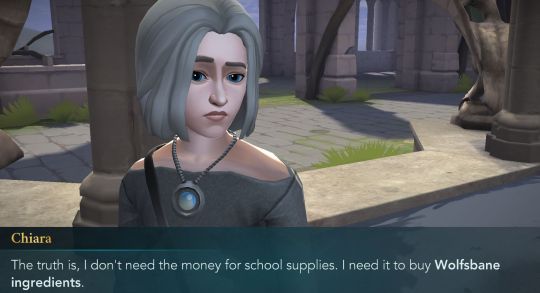
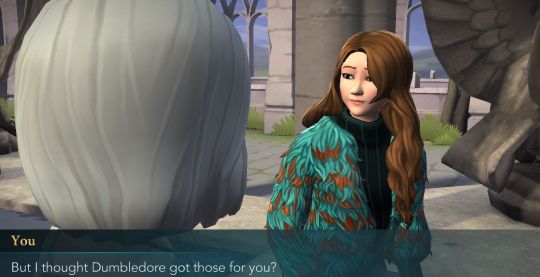


But then, as soon as Chiara gets money, she’s all happy that she’ll be able to get ingredients in time. So… Chiara needed only money to get ingredients? So, the quest basically implies that DUMBLEDORE DIDN’T WANT TO GIVE CHIARA MONEY FOR INGREDIENTS? I mean, if Chiara needed only money to be sure that she’ll make it in time, what exactly was stopping Dumbledore from getting the ingredients from the same source?
I’m sorry, but it’s so bullshit. You can say a lot about Dumbledore, but he wouldn’t refuse to give Chiara money in a situation like that. You also can’t tell me that he didn’t have money. And even if you want to believe that Albus would be a scumbag like that, we saw in the “Lone Wolf” TLSQ that Snape cares about Chiara a lot, so he would give her money. Hell, Snape would buy the ingredients himself, brew the Potion and deliver it to Chiara.
The way I see it, someone really wanted to put Chiara in this quest for some reason, but they knew it doesn’t exactly make sense – so they needed a scapegoat. Sadly, Ismelda was the easiest to turn into a bad guy of the story. Honestly, I don’t think that the writer of this quest was thinking anything about how we’re gonna view Ismelda. They just needed to distract the players. I hate to say it, but it’s kind of an equivalent of Merula’s sad backstory. Just in this case, it was rather: “Let’s not care about writing a logical side quest. Let’s make everyone worried about precious cinnamon roll Chiara instead”.
I’m sorry if these statements sound a bit too strong, but I’m really annoyed thinking about how many people were hating on Ismelda after this quest while I didn’t see much on how little sense this story made in general. And truth be told, this whole situation kind of made me dislike Chiara…
Overall, I hope that “The Quibbler” TLSQ was an exception when it comes to Ismelda’s character. I assume that her role will still be somewhere between [MC’s friend] and [Merula]. I mean, I believe that that’s how she is usually (“The Quibbler” TLSQ aside). That being said, I also expect that Jam City is not gonna remember all of the past stories, so I suppose that Ismelda will never be truly consistent.
I have no idea if I addressed your concerns properly. I hope I did. If not, as always, feel free to ask for clarification.
#long post#hogwarts mystery#hphm#ismelda murk#chiara lobosca#the quibbler tlsq#tulip karasu#jam city#ask#indigobackfire
14 notes
·
View notes
Note
Okay, final ward anon. Thank you for answering my asks, usually people just remove them when they see anything heaven’s ward adjacent. Zephirin got the worst cut considering he was almost voted in as lord commander and got described as a person valuing kindness and being honest and having a sense of justice and absolutely 0% of that is shown in game on top of the only other ward guys in game being the worst ones in the group dragging their rep down collectively. Not defending anyone though.
Look we're adults here I'm not gonna bite your head of for "defending" some online anime elves. They're written constructs that further a fictional story, not real men who did real crimes, and when I talk about characters I'm not thinking of them as people. They're part of a piece of art. Minor villains like this, in particular, can be very entertaining not just for the way they're depicted to act and how they move the plot, but for the pop culture legacy such small narrative fixtures leave, when only the particularly dedicated fan like you knows the extent of the writing that was otherwise scrapped or shoved aside. We like villains because they make things interesting and weird, it's completely fine lmao I'm sorry people eat your asks you've been very civil about it all and taught me about Cut Content -- I LOVE cut content.
6 notes
·
View notes
Note
i think that my biggest elder scrolls hot take is that like, the man/mer/beast divide is kind of a false or at the very least overly simple idea being placed on top of a much more complex thing to begin with but even if you were going to take it seriously orcs should be mer and bosmer should be beast.
I disagree! orcs are already elves, they don't get credit due to high elves supiority complex, orcs are called Orsimer even! I believe they're vaild as elves.
the line shouldn't exclude orcs from mer, but the line should seperate, Khajiit, wood elf, nord for example.
okay so i really hope you're checking back for an answer to this post. you're gonna get a lot of words in response and if no one reads them that'd be a bummer.
so we're on the same page that orcs are already elves and its just racism they're usually called a beast race.
but the hotter part of the take imo, and the part that made it clear to me how bullshit the whole categorization, is the bosmer part. because here's the thing: all the sources that say that bosmer share a common ancester with any other elves is non-bosmer, usually altmer or based on altmer sources. what bosmer tradition says is that they were the wild hunt before, and gained static forms via the Green Pact.
Now here's the thing. On its own okay thats two conflicting sources, personally I'm more inclined to trust the cultures own history but whatever. But there's a part in those stories that state that the Bosmer share an origin with the Khajiit (i cant remember at the moment at what point along the Wild Hunt to Bosmer line the Khajiit split off). And Khajiit histories agree.
And so the playable Mer races are two Elves that share a distant common ancestor and a bunch of ex shapeshifters that look like Elves. The playable Man races are two groups that split off from the Nords, one of whom also shares the common ancestor of the Mer, and the Redguard who as far as I'm aware don't share an ancestry with anyone else but they need to be called Men because not doing so would be racist in real life (a lot of stuff about the Redguard is racist in real life, thanks Bethesda.) And the playable Beast races are an elf race, a race closely related to the fake elves*, and the coolest motherfuckers on the planet who aren't related to any of these guys.
honestly the whole "beast race" category is just a mixed bag of anyone the other guys don't want to claim with a name that is... some synonym of dehumanizing that makes sense with non humans. I don't have a real conclusion here. sorry to anyone following me who isn't an elder scrolls head for engaging with its race realism so seriously. remember that the reason the evil sword belonging to the god of wishes stopped showing up in skyrim is because after oblivion it became a floating city above black marsh and no one ever talks about it in the games.
#original content#elder scrolls#tes#racism tw#kind of??#like i feel silly taggibg it that bexause this is fake but like#i feel like theres stuff in there that could trigger real world stuff and i want to be safe
4 notes
·
View notes